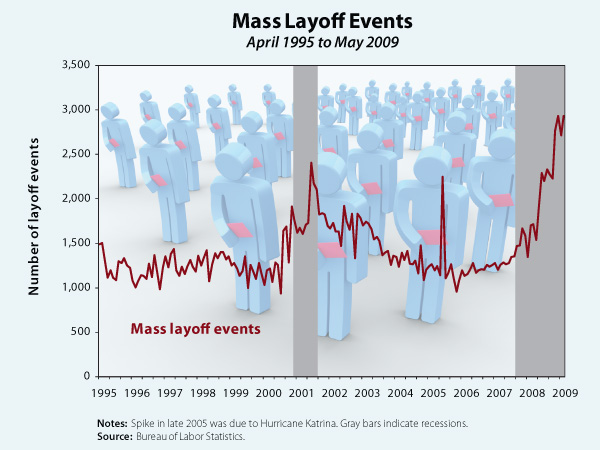|
DECEMBER 2009 UNEMPLOYMENT DATA*
(U.S.
BUREAU OF LABOR STATISTICS)
OFFICIAL UNEMPLOYMENT:
10.0%
A year earlier, the number of unemployed
persons was 11.4
million, and the jobless rate was 7.4 percent. [BLS]
| White |
9.0% |
| African
American |
16.2% |
| Hispanic |
12.9% |
| Asian** |
8.4% |
| Persons with a disability ** |
13.8% |
| Men
20 years and over |
10.2% |
| Women
20 years and over |
8.2% |
| Teen-agers
(16-19 years) |
27.1% |
| Black
teens |
48.4% |
| Officially
unemployed |
15.3
million |
HIDDEN UNEMPLOYMENT
| Working
part-time because can't find a full-time job: |
9.2
million |
| People
who want jobs but are
not looking so are
not counted in official statistics (of which about 2.5 million**
searched for work during the prior 12 months and were available
for work during the reference week.) |
6.3
million |
|
Total:
30.8 million (19.3% of the labor
force) |
Source: http://www.bls.gov/news.release/pdf/empsit.pdf
**Not seasonally adjusted.
*See Uncommon Sense #4 for an explanation of the unemployment measures.
In addition, millions
more were working full-time, year-round, yet earned
less than the official poverty level for a family of four. In
2008, the latest
year available, that number was 17.8 million, 17.1 percent of
full-time, full-year workers (estimated from Current
Population Survey, Bur. of the Census, 2009).
In October, 2009,
the latest month available, the number of job
openings was only 2.5 million, according to the BLS, Job
Openings and
Labor Turnover Estimates, December 8, 2009.+
Thus there are more than 12 job-wanters for each available job.[Numbers
are not comparable with previous months as methods have been revised.]
Comparing Long-Term Unemployment: 1999-2009

MONTHLY NET CHANGE IN
NON-FARM EMPLOYMENT, 12/07-9/09

Source: http://www.bls.gov/ces/
Change in Payroll Employment, Historical Data
Mass
layoffs: "Employers
initiated 1,776 mass layoff events in the third quarter of 2009
that resulted in the separation of 277,924 workers from their
jobs for at least 31 days, according to preliminary figures released
by the U.S. Bureau of Labor Statistics. The number of extended
mass layoff events reached a record high for any third quarter
(with data available back to 1995). Third quarter program highs
in the number of events were also recorded in half of the 18 major
industry sectors, 2 of the 4 geographic regions, 4 of the 9 divisions,
and 15 states.
Manufacturing firms reported 511 extended mass
layoff events involving 80,135 separations in third quarter 2009
and were responsible for 29 percent of private nonfarm extended
layoff events and related separations. A year earlier, manufacturing
made up 31 percent of events and 33 percent of separations.
Nine major industry sectors reported third quarter
program highs in 2009 in terms of the number of extended mass
layoff events in the private nonfarm sector—construction;
wholesale trade; transportation and warehousing; professional
and technical services; management of companies and enterprises;
administrative and waste services; educational services; arts,
entertainment, and recreation; and other services, except public
administration.
Among the four census regions, the West and the
Midwest recorded the highest numbers of separations due to extended
mass layoff events in the third quarter of 2009. All regions except
the West reported over-the-year decreases in the number of separations.
(See table 4.) Among the nine census divisions, the highest numbers
of separations during the third quarter of 2009 were in the Middle
Atlantic, East North Central, South Atlantic, and Pacific. (See
table 4.) Only three divisions reported over-the-year increases
in terms of the numbers of separations—New England, West
North Central, and Mountain." (BLS,
November 10, 2009)

Source: http://www.epi.org/publication/snapshot_20090701/
+"Over the 12 months
ending in October, the job openings rate (not seasonally adjusted)
decreased for total nonfarm, total private, and government. The
job openings rate also decreased in many industries: mining and
logging; durable goods manufacturing; nondurable goods manufacturing;
retail trade; transportation, warehousing, and utilities; information;
educational services; health care and social assistance; arts,
entertainment, and recreation; accommodation and food services;
and state and local government. The job openings rate decreased
in 3 of the 4 regions—Midwest, Northeast, and South."
The
National Jobs for All Coalition is a project of the Council on
Public and International Affairs. |

